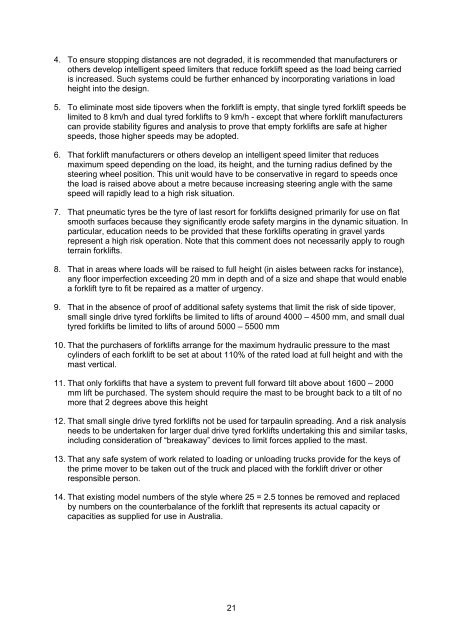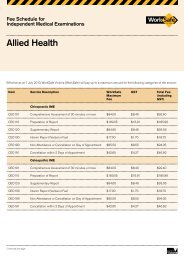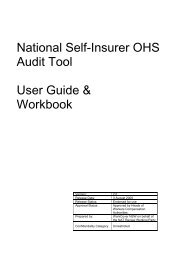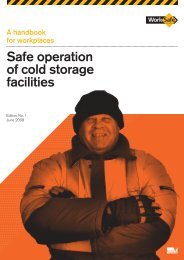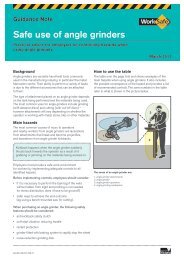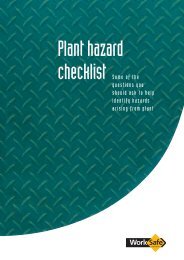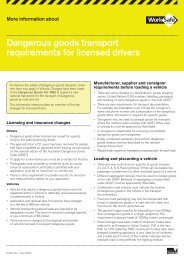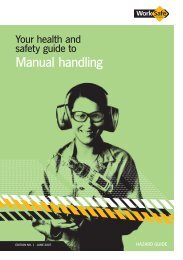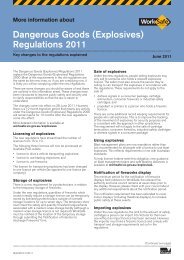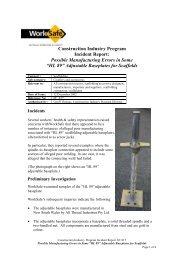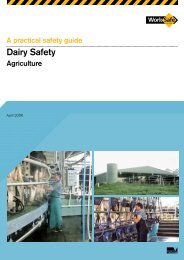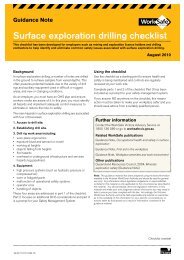Forklift stability and other technical safety issues - Monash University
Forklift stability and other technical safety issues - Monash University
Forklift stability and other technical safety issues - Monash University
Create successful ePaper yourself
Turn your PDF publications into a flip-book with our unique Google optimized e-Paper software.
4. To ensure stopping distances are not degraded, it is recommended that manufacturers or<strong>other</strong>s develop intelligent speed limiters that reduce forklift speed as the load being carriedis increased. Such systems could be further enhanced by incorporating variations in loadheight into the design.5. To eliminate most side tipovers when the forklift is empty, that single tyred forklift speeds belimited to 8 km/h <strong>and</strong> dual tyred forklifts to 9 km/h - except that where forklift manufacturerscan provide <strong>stability</strong> figures <strong>and</strong> analysis to prove that empty forklifts are safe at higherspeeds, those higher speeds may be adopted.6. That forklift manufacturers or <strong>other</strong>s develop an intelligent speed limiter that reducesmaximum speed depending on the load, its height, <strong>and</strong> the turning radius defined by thesteering wheel position. This unit would have to be conservative in regard to speeds oncethe load is raised above about a metre because increasing steering angle with the samespeed will rapidly lead to a high risk situation.7. That pneumatic tyres be the tyre of last resort for forklifts designed primarily for use on flatsmooth surfaces because they significantly erode <strong>safety</strong> margins in the dynamic situation. Inparticular, education needs to be provided that these forklifts operating in gravel yardsrepresent a high risk operation. Note that this comment does not necessarily apply to roughterrain forklifts.8. That in areas where loads will be raised to full height (in aisles between racks for instance),any floor imperfection exceeding 20 mm in depth <strong>and</strong> of a size <strong>and</strong> shape that would enablea forklift tyre to fit be repaired as a matter of urgency.9. That in the absence of proof of additional <strong>safety</strong> systems that limit the risk of side tipover,small single drive tyred forklifts be limited to lifts of around 4000 – 4500 mm, <strong>and</strong> small dualtyred forklifts be limited to lifts of around 5000 – 5500 mm10. That the purchasers of forklifts arrange for the maximum hydraulic pressure to the mastcylinders of each forklift to be set at about 110% of the rated load at full height <strong>and</strong> with themast vertical.11. That only forklifts that have a system to prevent full forward tilt above about 1600 – 2000mm lift be purchased. The system should require the mast to be brought back to a tilt of nomore that 2 degrees above this height12. That small single drive tyred forklifts not be used for tarpaulin spreading. And a risk analysisneeds to be undertaken for larger dual drive tyred forklifts undertaking this <strong>and</strong> similar tasks,including consideration of “breakaway” devices to limit forces applied to the mast.13. That any safe system of work related to loading or unloading trucks provide for the keys ofthe prime mover to be taken out of the truck <strong>and</strong> placed with the forklift driver or <strong>other</strong>responsible person.14. That existing model numbers of the style where 25 = 2.5 tonnes be removed <strong>and</strong> replacedby numbers on the counterbalance of the forklift that represents its actual capacity orcapacities as supplied for use in Australia.21


